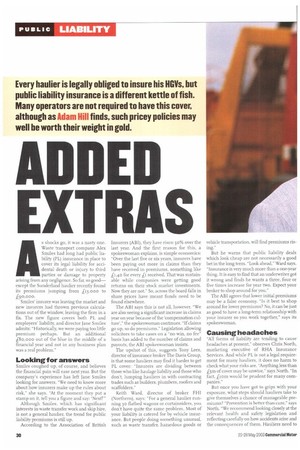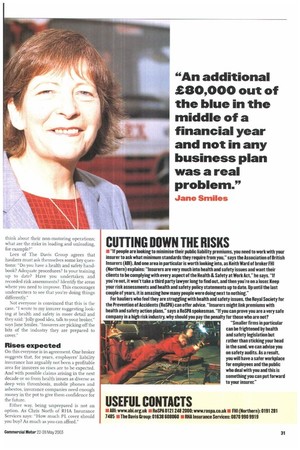EXTRAS
Page 30

Page 31

If you've noticed an error in this article please click here to report it so we can fix it.
As shocks go, it was a nasty one. Waste transport company Alex Smiles had long had public liability (PL) insurance in place to cover its legal liability for accidental death or injury to third parties or damage to property arising from any negligence. So far, so good— except the Sunderland haulier recently found its premiums jumping from £13,000 to £90,000.
Smiles insurer was leaving the market and new insurers had thrown previous calculations out of the window, leaving the firm in a fix. The new figure covers both PL and employers' liability, and director Jane Smiles admits: "Historically, we were paying too little premium perhaps. But an additional i8 o,000 out of the blue in the middle of a financial year and not in any business plan was a real problem."
Looking for answers
Smiles coughed up, of course, and believes the financial pain will ease next year. But the company's experience has left Jane Smiles looking for answers. "We need to know more about how insurers make up the rules about risk," she says. "At the moment they put a stamp on it, tell you a figure and say: ' Next!"
Although Smiles, which has significant interests in waste transfer work and skip hire, is not a general haulier, the trend for public liability premiums is still up.
According to the Association of British Insurers (ABI), they have risen 5o% over the last year. And the first reason for this, a spokeswoman explains, is simple economics: "Over the last five or six years, insurers have been paying out more in claims than they have received in premiums, something like i1.40 for everyi received. That was sustainable while companies were getting good returns on their stock market investments. Now they are not." So, across the board falls in share prices have meant funds need to be found elsewhere, The ABI says this is not all, however. "We are also seeing a significant increase in claims year on year because of the 'compensation culture'," the spokeswoman continues. "If claims go up, so do premiums." Legislation allowing solicitors to take cases on a "no win, no fee" basis has added to the number of claims and payouts, the ABI spokeswoman insists.
The upshot of this, suggests Tony Lees, director of insurance broker The Davis Group, is that some hauliers may find it harder to get PL cover: "Insurers are dividing between those who like haulage liability and those who don't, lumping hauliers in with contracting trades such as builders, plumbers, roofers and scaffolders."
Keith Ward, director of broker FHI (Northern), says: "For a general haulier running 30 flatbed wagons or curtainsiders, you don't have quite the same problem. Most of your liability is catered for by vehicle insurance. But people doing something unusual, such as waste transfer, hazardous goods or
vehicle transportation, will find premiums rising,"
But he warns that public liability deals which look cheap are not necessarily a good bet in the long term. "Look ahead," Ward says. "Insurance is very much more than a one-year thing. It is easy to find that an underwriter got it wrong and finds he wants a three, four or five times increase for year two. Expect your broker to shop around for you."
The ABI agrees that lower initial premiums may be a false economy. "Is it best to shop around for lower premiums? No, it can be just as good to have a long-term relationship with your insurer so you work together," says its spokeswoman.
Causing headaches
"All forms of liability are tending to cause headaches at present," observes Chris North, marketing executive of RHA Insurance Services. And while PL is not a legal requirement for many hauliers, it does no harm to check what your risks are. "Anything less than Lm of cover may be unwise," says North. "In fact. Dom would be prudent for many companies."
But once you have got to grips with your exposure, what steps should hauliers take to give themselves a chance of manageable premiums? "Prevention is better than cure," says North. "We recommend looking closely at the relevant health and safety legislation and reflecting carefully on how accidents arise and the consequences of them. Hauliers need to
think about their non-motoring operations; what are the risks in loading and unloading, for example?"
Lees of The Davis Group agrees that hauliers must ask themselves some key questions: "Do you have a health and safety handbook? Adequate procedures? Is your training up to date? Have you undertaken and recorded risk assessments? Identify the areas where you need to improve. This encourages underwriters to see that you're doing things differently."
Not everyone is convinced that this is the case. "I wrote to my insurer suggesting looking at health and safety in more detail and they said: 'Jolly good idea, talk to your broker," says Jane Smiles. "Insurers are picking off the bits of the industry they are prepared to cover."
Rises expected
On this everyone is in agreement. One broker suggests that, for years, employers' liability insurance has arguably not been a profitable area for insurers so rises are to be expected. And with possible claims arising in the next decade or so from health issues as diverse as deep vein thrombosis, mobile phones and asbestos, insurance companies need enough money in the pot to give them confidence for the future.
Either way, being unprepared is not an option. As Chris North of RHA Insurance Services says: "How much PL cover should you buy? As much as you can afford."
































































































































































